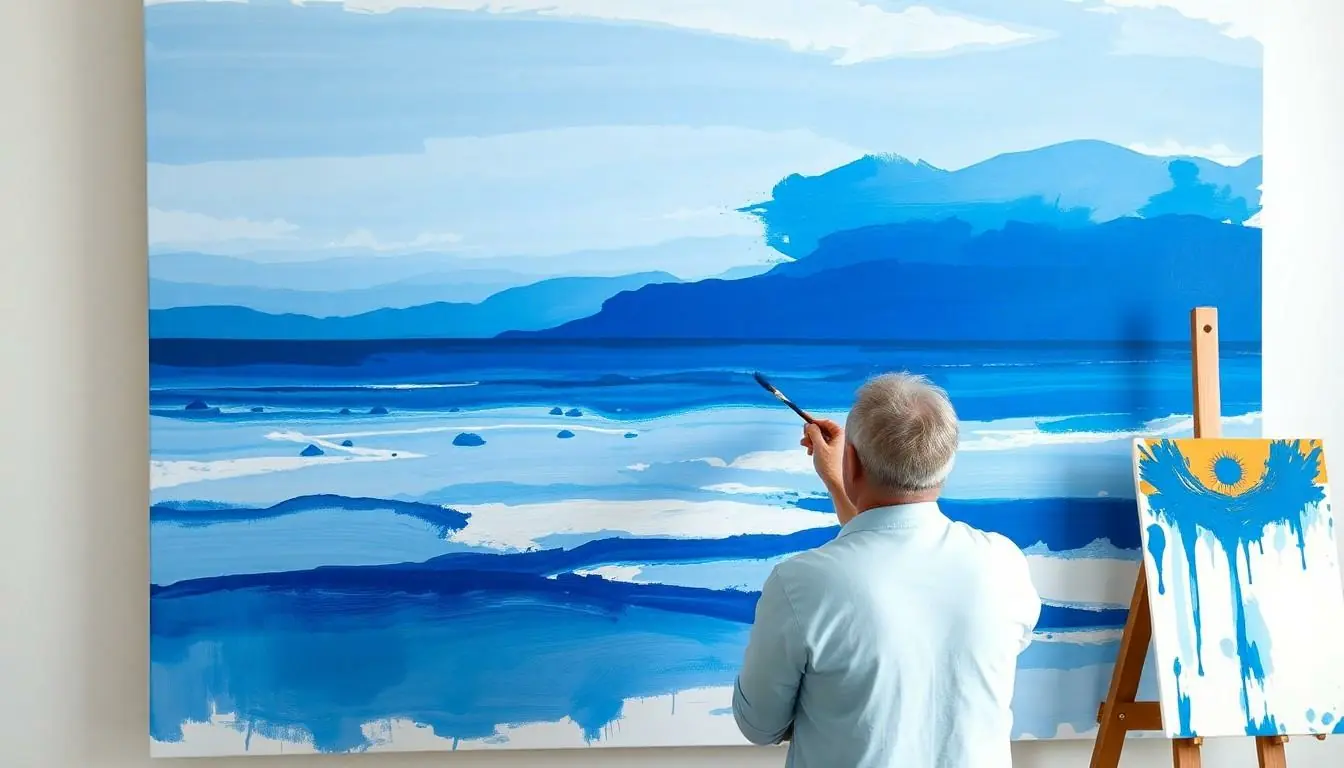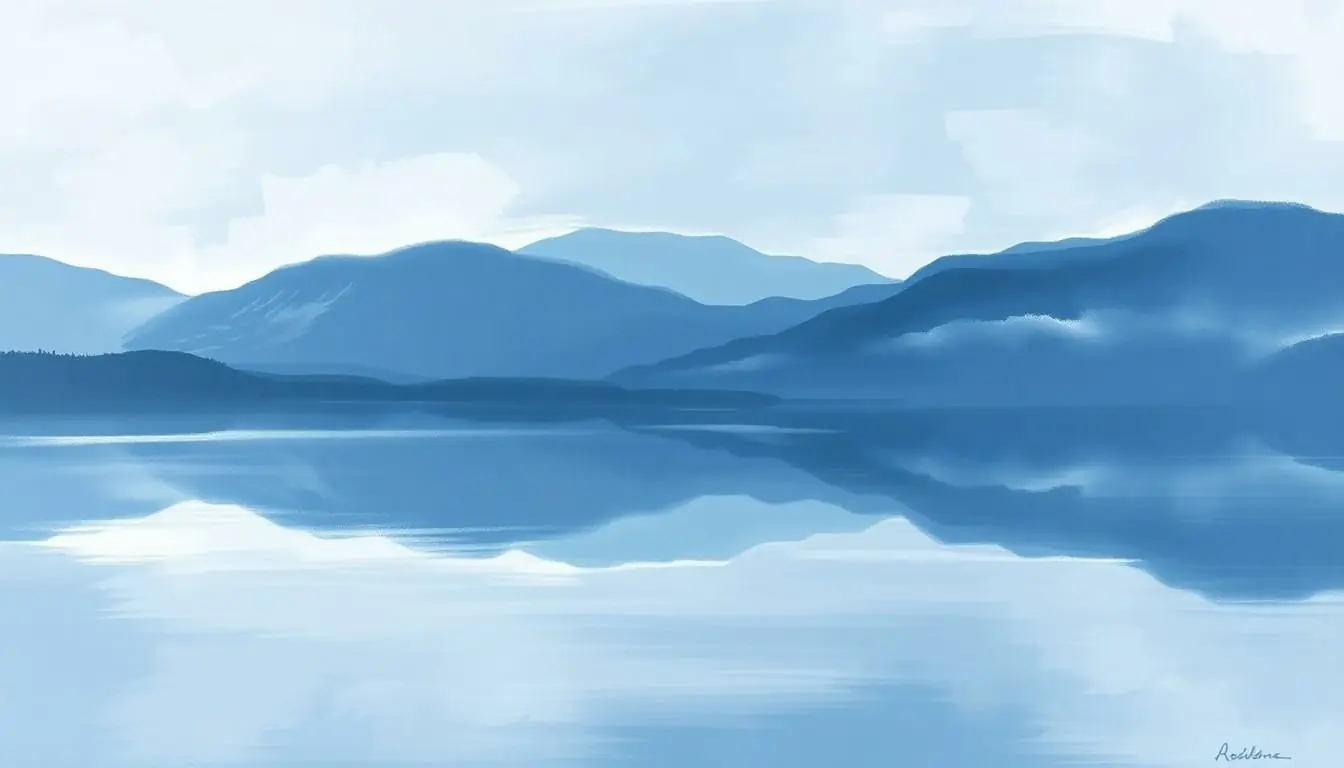Table of Contents
ToggleImagine a world where every hue sings in harmony, where the beauty of nature is distilled into a single color palette. Monochromatic landscape painting does just that, transforming the ordinary into the extraordinary with a minimalist twist. It’s like wearing a classic black turtleneck—simple yet undeniably chic.
Understanding Monochromatic Landscape Painting
Monochromatic landscape painting utilizes a single color to convey depth and emotion. This technique emphasizes subtle variations in tone and texture, transforming the ordinary into the extraordinary.
Definition and Characteristics
Monochromatic landscape painting involves using one dominant color, allowing artists to explore various shades and tints. It focuses on light and shadow while minimizing distractions. Such paintings elicit strong emotional responses through tonal contrasts and harmonious compositions. Artists often create mood and atmosphere, leading viewers on a visual journey. The simplicity of this style highlights fundamental elements like shape and form, making the landscapes more engaging.
Historical Context
Monochromatic landscape painting has roots in various art movements. The early 20th century saw artists like Kazimir Malevich use monochrome techniques to challenge perceptions. This approach redefined traditional landscapes, shifting focus from naturalism to abstraction. In the 1960s, minimalism emerged, emphasizing simplicity and color theory. Artists such as Robert Ryman demonstrated how a single color could communicate depth and meaning. Over time, this style evolved, influencing contemporary art and expanding possibilities in landscape representation.
Techniques in Monochromatic Landscape Painting

Monochromatic landscape painting employs specific techniques to enhance visual impact. Two vital components are color palette selection and brushwork texture.
Color Palette Selection
Choosing the right color palette is crucial in monochromatic landscape painting. Artists typically select a single color and its variations, including shades and tints, to convey mood and atmosphere. A limited color scheme allows for experimentation with subtle transitions, fostering a cohesive visual experience. For instance, selecting blue tones can evoke tranquility and serenity, while using reds might impart warmth and intensity. Emphasizing relationships between lighter and darker shades enhances depth perception in the artwork.
Brushwork and Texture
Brushwork techniques significantly influence the overall texture of a monochromatic landscape. Different strokes produce varied effects, ranging from soft blends to pronounced textures. Applying thick paint creates dimension, while thin layers contribute to a smooth appearance. Artists often utilize techniques such as scumbling or glazing, which further enrich the texture. Additionally, varying brush sizes enables intricate details and broader strokes for landscapes. Effective brushwork transforms simple elements into compelling narratives within the painting.
Influential Artists in Monochromatic Landscape Painting
Several artists significantly shaped monochromatic landscape painting, pushing boundaries and expanding its expressive capabilities. Their innovative works and techniques convey profound emotions and narratives.
Notable Works and Contributions
Kazimir Malevich’s “Black Square” exemplifies the early exploration of monochrome, challenging the perception of space and form. Mark Rothko’s ethereal color field paintings express deep emotional resonance, often using a limited palette to evoke specific feelings. Yves Klein’s signature blue, used in “IKB 191,” captured the essence of the sky and ocean, showcasing the depth achievable through a monochromatic approach. These artists laid the groundwork for practitioners who utilize simplicity to elevate visual impact.
Modern Interpretations
Contemporary artists frequently experiment with monochromatic landscapes by integrating new materials and methods. Anselm Kiefer’s poignant representations of nature often employ earth tones to convey historical depth and existential themes. Julie Mehretu’s layered compositions utilize monochromatic elements to explore urban landscapes and memories, pulling viewers into a complex dialogue. Additionally, artists like Olafur Eliasson implement light and environment to reimagine the monochromatic landscape, inviting interaction and perception shifts.
The Impact of Monochromatic Landscape Painting
Monochromatic landscape painting profoundly influences viewers through its focused aesthetic. This technique evokes various emotional and psychological reactions.
Emotional and Psychological Effects
Artists effectively use monochromatic palettes to create mood. Blue tones resonate with calmness, while reds evoke passion or warmth. Subtle variations prompt contemplation, encouraging viewers to engage with the artwork. Artists intentionally manipulate light and shadow to enhance emotional depth. This approach fosters a connection between the observer and the landscape, allowing for personal introspection.
Cultural Significance
Monochromatic landscape painting holds significant cultural relevance across various movements. Early 20th-century artists challenged conventional norms, pushing boundaries of color and form. This style reflects societal changes and artistic experimentation, emphasizing minimalism’s rise in the 1960s. Artists like Yves Klein transformed perceptions of landscape by integrating cultural elements, highlighting the interaction between humanity and nature. Contemporary artists continue to explore this dialogue, further solidifying the style’s importance in art history and its ongoing evolution.
Monochromatic landscape painting stands as a testament to the power of simplicity in art. By focusing on a single color, artists can evoke profound emotions and create intimate connections with viewers. This minimalist approach not only highlights the beauty of subtle variations in tone and texture but also invites deeper reflection on the landscapes being portrayed.
As contemporary artists continue to explore and redefine this style, the dialogue surrounding monochromatic landscapes remains vibrant and relevant. The ability to convey complex narratives through a limited palette showcases the endless possibilities within this art form. Embracing monochromatic techniques not only enriches the artistic experience but also encourages audiences to appreciate the inherent beauty found in simplicity.




